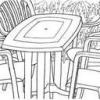Re: those experiments which purport to prove the Greenhouse Effect

Here’s a typical example:
Can anybody see the ‘glaring’ error?
The explanation goes that the atmosphere is largely transparent to shortwave sunlight (wavelength less than 4 microns); the surface is warmed by shortwave sunlight; the surface emits longwave radiation (anything more than 4 microns) – all of this is clearly true so far. Greenhouse gases reflect or reradiate 83% of this longwave back down to the surface; the surface this receives twice as much ‘back radiation’ as it does actual sunlight (source). CO2 accounts for about one-fifth of this ‘back radiation’ (I think. The precise fraction is never made clear, but clearly it’s enough to make a difference if the explanation is correct. You can’t just add radiation from different sources either, but hey).
[While it is quite true that the atmosphere is radiating back at the surface and you can measure it, the atmosphere is cooler than the surface (because of the gravity induced lapse rate - if CO2 really 'trapped' warmth, the lapse rate would be higher than expected from first principles) and the net transfer of heat (whether by radiation or conduction) will always be from warm to cool, but that's an aside, and even this basic truth is 'hotly' disputed by Alarmists, so let's concede on that to keep the peace.]
What we see in this experiment is primarily the two hot lamps warming up the two bottles and the gas in them. That’s the ‘glaring’ error. The lamps are emitting lots of radiation at at wavelengths 14 – 16 microns, which CO2 absorbs (but N2 and O2 can’t), warming up the CO2 (see bullet point 1 here). There is nothing magical about this; leave a piece of aluminium and a piece of wood in bright sunlight, the aluminium will reach a higher temperature.
A much fairer experiment would be to have three large greenhouse frames (the larger the better) covered in very thin, clear polythene (which allows most radiation through in both directions) in a shaded area, so that the only radiation they receive is longwave from the ground and from the surrounding atmosphere (which is much less intense than the light emitted by a hot lamp). You have one full of normal air; one full of CO2; and one full of argon (monatomic and definitely not a greenhouse gas, as defined) as a control experiment.
CO2 and argon have a similar mass per unit volume and both have much lower specific heat capacity than normal air (see bullet point 5 of previous link); they also both have similar thermal conductivity, much lower than normal air (i.e. they are better insulators). Put your aluminium and wood in a freezer and the aluminium will cool down faster as it is a better conductor/worse insulator.
I’d be surprised if the greenhouse full of CO2 reached a steady state temperature (after a few days, averaged over a 24-hour period) higher than that of the greenhouse with normal air. That would be like putting our aluminium and wood in a larder and noticing a few days later that they are different temperatures. And even if it did, we have the argon-filled greenhouse as a control. The chances are, it would be a similar temperature to the one with CO2 i.e. most of the differences can be explained by their lower specific heat capacity and conductivity i.e. the influence of longwave radiation can be ruled out.
To the extent that the 100% CO2 greenhouse is slightly warmer than the one with normal air, you adjust for its other properties by comparing it with the temperature in the 100% argon greenhouse (see previous paragraph) to arrive at a much smaller (and possibly negative) figure which will be the result of radiation ‘trapping’. If it’s negative, then stop right there. If it’s positive, you divide that temperature difference by 3,333 to estimate the likely increase in temperature if CO2 levels were to double from their ‘pre-industrial’ level, i.e. from 0.03% to 0.06%. For completeness, normal air is 1% argon by volume, i.e. there’s 2,500 times as much argon as there is CO2.
Source: http://markwadsworth.blogspot.com/2021/02/re-those-experiments-which-purport-to.html
Anyone can join.
Anyone can contribute.
Anyone can become informed about their world.
"United We Stand" Click Here To Create Your Personal Citizen Journalist Account Today, Be Sure To Invite Your Friends.
Please Help Support BeforeitsNews by trying our Natural Health Products below!
Order by Phone at 888-809-8385 or online at https://mitocopper.com M - F 9am to 5pm EST
Order by Phone at 866-388-7003 or online at https://www.herbanomic.com M - F 9am to 5pm EST
Order by Phone at 866-388-7003 or online at https://www.herbanomics.com M - F 9am to 5pm EST
Humic & Fulvic Trace Minerals Complex - Nature's most important supplement! Vivid Dreams again!
HNEX HydroNano EXtracellular Water - Improve immune system health and reduce inflammation.
Ultimate Clinical Potency Curcumin - Natural pain relief, reduce inflammation and so much more.
MitoCopper - Bioavailable Copper destroys pathogens and gives you more energy. (See Blood Video)
Oxy Powder - Natural Colon Cleanser! Cleans out toxic buildup with oxygen!
Nascent Iodine - Promotes detoxification, mental focus and thyroid health.
Smart Meter Cover - Reduces Smart Meter radiation by 96%! (See Video).





